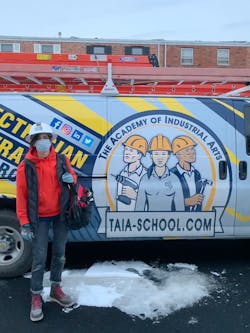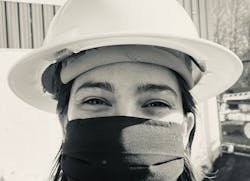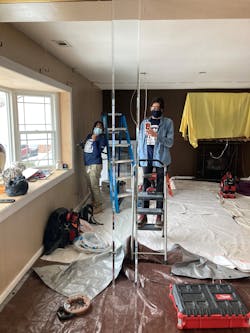It is no secret by now that the COVID-19 pandemic brought many negative changes to people around the world, affecting a wide range of industries. But for some, it provided an opportunity for reflection on what was most important career-wise and a realization that some fields (including the electrical industry) would always be essential.
For then 36-year-old Marilyn Candelero of Philadelphia, the pandemic helped provide the time and opportunity for her to make the career switch she was looking for — into the hands-on electrical industry, and, in particular, clean energy. With a college background in communications and finance, Candelero has spent the last 20 years working in the hospitality industry, starting in the front of house at bars and restaurants. Most recently, she was vice president at a microbrewery in Philadelphia for 11 years where she held a range of roles. Starting as a graphic designer part time, she quickly moved into management and operations alongside the brewery’s owner. In her time there, the business opened three new locations, doubled its production size, and more. When the pandemic hit — and the restaurant industry, including the brewery she worked at, was forced to shut down — she realized now was the time to make the career shift she’d been contemplating for the last two years.
Although she loved her time at the microbrewery, she was looking for something more hands-on where she could still use the skills gained from the restaurant industry. Candelero says working in the hospitality industry meant engaging with people daily, and restaurant management meant solving problems on a regular basis. This isn’t unlike electrical work, notes Candelero, whether that is working with homeowners and customers or figuring out how to fix something to make it safer or more efficient. “I felt like I had these skill sets,” she says. “How else can I use them?”
When the pandemic forced a shutdown on her place of employment, Candelero says it finally “made it more possible” to feel like she could transition into a new profession of choice and begin electrical training. So, in September of 2020, she began her first semester at The Academy of Industrial Arts (TAIA), created and run by Harold De Loach, a contributor to EC&M’s E-Train e-newsletter, while she looked for her new dream role: work on a team for a green company, ideally with a social, cultural, and environmental mission. While she realized she might not necessarily want to go to the traditional route of becoming an apprentice, she wanted the opportunity to be able to learn hands-on electrical skills in order to better prepare herself for work in the clean energy sector and speak the language of those working around her — ironically similar to her former role in the hospitality industry.
During the course of her electrical training period with De Loach, which she pursued for about eight months prior to accepting a full-time position in April with a B-corp solar company in Philadelphia, Candelero says the first semester was primarily classroom-based in the form of Zoom classes with about 10% out of class. In her second semester, she spent more time on job sites with DeLoach and other students really getting into the hands-on learning portion of the job. At the time of this interview in March, Candelero says they spent most of 2021 rewiring a house that had aluminum wiring, learning how to do the work while making the least number of holes possible, which Candelero says she found exciting, especially after reflecting on an electrical job done at her own home years before where large holes were left in the walls. Other work she has done through TAIA includes pulling new wires and routing them through high ceilings at an arcade; pulling MC cable for fryers and high-voltage machines at some other arcades; retrofitting LED lighting at a factory; and other small residential projects.
One thing she loved about her classes is the diversity. In fact, Candelero says the students’ ages in her ranged from about 19 years old to upward of 55, and 20% of her class consisted of women. In a traditionally male-dominated field, Candelero thinks her experiences as a female help make her uniquely prepared for electrical work, including her time in the largely male-dominated microbrewery business. When Candelero is on job sites with classmates, she says she has had overwhelmingly positive experiences working as a team with both her male and female counterparts, helping each other out as needed. She admits she has had to ask for help for some of the more physically demanding tasks. On the flip side, however, male classmates have asked her and other female peers for help reaching into smaller spots or performing work in more crowded spaces.
While it may be intimidating, Candelero advises those looking to enter the electrical field not to be afraid to question the norm. “If you’re in the thick of the job, and you do feel challenged by the lack of diversity, which I don’t think is really going to be a major problem in the near future, just remember your strengths,” she says. “We can do this. We’re strong enough to work collectively – men, women, Black, White, Asian, anything you name.”
In April, eight months after her initial training at TAIA began, she began her first full-time role in the electrical field as efficiency manager at Solar States, a dual mission installer, educator, and trainer based in Philadelphia that provides a path for inner city youth and returning citizens to become installers, most of whom have had little to no exposure to the electrical industry. She discovered the opportunity through the Philadelphia Energy Authority, which is working to move the city toward green and clean energy. “Solar States is empowering Philadelphians and keeping the inner city in the conversation of clean, affordable energy,” she says.
Since her role is new to the company and continuing to evolve, she currently analyzes how processes can possibly be more streamlined, with tasks such as tracking racking types to their install times and other operations that can be considered. She also works with marketing. Because the company focuses on hiring people new to the electrical installation industry (especially the solar market), Candelero says there are inherent challenges with the model of onboarding, empowering, and educating the next generation. “They’ve got a lot to juggle with this pivotal model, but they do it well and they look to improve on that. I really respect the company because of its mission to keep the city employed with good jobs,” she says.
While the new role keeps her busy, Candelero says she likes to hang out with the installers as much as she can and is getting training from the founder on the ins and outs of solar, including specifics such as DC to AC power, optimization, racking, roofing, and more. Despite the fact that she had to stop taking classes at TAIA due to her full-time work, she plans to take DeLoach’s next course for the Code in the near future. “It’s a little early for what I’ll be able to use it for, but I think it will help me understand a lot of the things going on with the interconnection of the solar power to the power of the house,” she says. “And I just want to keep understanding the language.”
Now that she is in a role that encompasses her career aspirations and is continuing her path of electrical training, Candelero wants to remind those who are considering entering the field (including women or those wanting to switch careers) that there is a place for them. “I really think my main messaging is that even if you don’t see it, if it doesn’t look like it’s talking to you,” Candelero says of the electrical industry, “you’re needed and you’re valuable.”
About the Author
Ellie Coggins Angus
Ellie Coggins Angus is the managing editor for EC&M and was formerly the associate editor for Electrical Wholesaling. She has more than five years of experience in the B2B publishing space covering the electrical contracting/wholesaling industry. Ellie received an MA in journalism from Syracuse University and a BA in English from University of Cincinnati. She is currently based in Cincinnati, Ohio. Connect with her at [email protected] or on LinkedIn.



